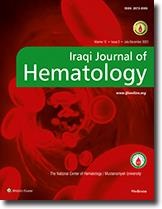Abstract
ABSTRACT:
Background: Human herpesvirus type 6 (HHV-6) is associated with roseola infantum
during childhood followed by life-long latency that periodically reactivated in
immunocompromised individuals. In spite of several studies to establish the pathogenic
role of HHV-6 in lymphoid malignancies, the issue is still controversial.
Objectives: This study was arranged to explore the association of HHV-6 infection in
lymphoid malignancies using different serological and molecular techniques and to
quantify the plasma viral load.
Patients and methods: This cross-sectional case control study was conducted in
National Center for Hematological Diseases (NCHD) at Al-Mustansiriyah University
and Baghdad Teaching Hospital (BTH) in Baghdad-Iraq from September 2013 till
April 2015. The patient group consists of 11 patients with Hodgkin lymphoma and
39 Non-Hodgkin's lymphoma of both sexes. The age range was between 15-80 years.
The diagnosis of lymphomas was based on hematological and histopathological
criteria. 59 apparently healthy individuals were enrolled as control group. They were
chosen from unpaid blood donors. The age range was between 18-59 years. Human
privacy was respected by taken participant's oral consensus. The seropositivity rate of
anti-HHV-6 IgG and IgM antibodies were detected by enzyme linked immunosorbent
assay (ELISA) and indirect immunofluorescent test (IFAT). The molecular detection
and determination of plasma viral DNA load was achieved by quantitative polymerase
chain reaction (qPCR). All data were statistically analyzed, and P values < 0.05 were
considered significant.
Results: The anti-HHV-6 IgG positivity rate by IFAT was insignificantly higher in HL
(81.8% vs 61.0% p=0.186) and NHL (64.1% vs 61.0%, p =0.758) compared to control
group. The anti-HHV-6 IgG positivity rate by ELISA was 81.8% in HL, 84.6% in
NHL versus 72.9 % in controls which were insignificant in both groups (p=0.534 and
p=0.173) respectively. The anti-HHV-6 IgM positivity rate by ELISA technique
among patients with HL was significantly higher compared to controls (27.2% vs 6.8%,
p= 0.038), but not significant in NHL (17.9% vs 6.8%, p= 0.086). HHV-6 DNA was
detected in (27.3%) patients with HL by PCR technique, but none of the controls or
NHL patients was positive. The plasma viral DNA load of the patient with HL was
1.4± 0.3 x105 copies/milliliter.
Conclusion: Although a higher anti-HHV-6 antibodies positivity rate among patients
with HL and NHL, the pathogenic role of the virus in the development of these
malignancies was difficult to be ascertain.
Background: Human herpesvirus type 6 (HHV-6) is associated with roseola infantum
during childhood followed by life-long latency that periodically reactivated in
immunocompromised individuals. In spite of several studies to establish the pathogenic
role of HHV-6 in lymphoid malignancies, the issue is still controversial.
Objectives: This study was arranged to explore the association of HHV-6 infection in
lymphoid malignancies using different serological and molecular techniques and to
quantify the plasma viral load.
Patients and methods: This cross-sectional case control study was conducted in
National Center for Hematological Diseases (NCHD) at Al-Mustansiriyah University
and Baghdad Teaching Hospital (BTH) in Baghdad-Iraq from September 2013 till
April 2015. The patient group consists of 11 patients with Hodgkin lymphoma and
39 Non-Hodgkin's lymphoma of both sexes. The age range was between 15-80 years.
The diagnosis of lymphomas was based on hematological and histopathological
criteria. 59 apparently healthy individuals were enrolled as control group. They were
chosen from unpaid blood donors. The age range was between 18-59 years. Human
privacy was respected by taken participant's oral consensus. The seropositivity rate of
anti-HHV-6 IgG and IgM antibodies were detected by enzyme linked immunosorbent
assay (ELISA) and indirect immunofluorescent test (IFAT). The molecular detection
and determination of plasma viral DNA load was achieved by quantitative polymerase
chain reaction (qPCR). All data were statistically analyzed, and P values < 0.05 were
considered significant.
Results: The anti-HHV-6 IgG positivity rate by IFAT was insignificantly higher in HL
(81.8% vs 61.0% p=0.186) and NHL (64.1% vs 61.0%, p =0.758) compared to control
group. The anti-HHV-6 IgG positivity rate by ELISA was 81.8% in HL, 84.6% in
NHL versus 72.9 % in controls which were insignificant in both groups (p=0.534 and
p=0.173) respectively. The anti-HHV-6 IgM positivity rate by ELISA technique
among patients with HL was significantly higher compared to controls (27.2% vs 6.8%,
p= 0.038), but not significant in NHL (17.9% vs 6.8%, p= 0.086). HHV-6 DNA was
detected in (27.3%) patients with HL by PCR technique, but none of the controls or
NHL patients was positive. The plasma viral DNA load of the patient with HL was
1.4± 0.3 x105 copies/milliliter.
Conclusion: Although a higher anti-HHV-6 antibodies positivity rate among patients
with HL and NHL, the pathogenic role of the virus in the development of these
malignancies was difficult to be ascertain.
Keywords
Hodgkin's lymphoma
Human herpesvirus-6
lymphoid malignancies
